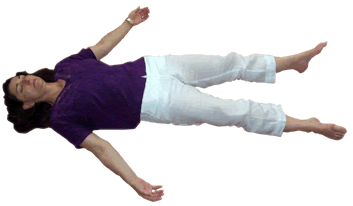RELAXATION
Every yoga session should end with a period of relaxation. In yoga this is called Savasana, or the Pose of the Corpse because your body should take on all the qualities of a corpse except that you continue to breath. When I first started doing yoga my teacher told me that this was the most difficult of all the yoga postures and I thought that she was joking. She was not. To reach complete relaxation takes time and practice. The posture for relaxation is always the same. However there are numerous mental exercises and techniques that one can use. You can picture yourself on a beach or in a forest or garden. The secret is to explore your imaginary environment with all your senses. See the colours of the plants, feel the breeze, catch the scents of the flowers and listen to the sound of the birds and water. The possibilities are endless.

First of all put on some soft, soothing music and place a few drops of your favourite aromatherapy oil into the burner. Take the telephone off of the hook and switch off the cell phone. To practice Savasana lie flat on your back with your feet hip distance apart and allow the big toes to move away from each other. Let your arms lie away from your body at a 45 degree angle with the back of the hands on the floor and the palms facing upwards. Close your eyes.
Do ten rounds of ujjayi breathing and then allow your body to take on its natural breathing rhythm, moving into a shallower breath. Consciously count the ujjayi breaths as this stops the mind from wondering.
Inhale and point your toes and then exhale and relax.
Inhale and flex your feet and then exhale and relax.
Inhale and pull your buttock muscles so tight that they vibrate against the floor, exhale and relax.
Inhale and push the small of your back into the floor, exhale and relax.
Inhale and make tight fists with your hands, exhale and relax.
Inhale and extend your fingers, hands and arms, until the shoulder blades move away from each other on the floor underneath you, then exhale and relax.
Screw up your face like a wrinkled, old prune and move your facial muscles vigorously about. (This is the one part of the body that hardly ever gets exercised, yet it is the part that we show to the world and never cover.) Relax your face.
Gently roll your head from side to side until it feels heavy.
Check that your are not clenching your teeth and that your tongue is not stuck to the pallet. Let it lie softly in the base of your mouth. Relax your forehead, cheeks and chin.
Visualise a red wheel of energy spinning around at the base of your spine. Have a good look at this wheel. Notice the tone of the red and see how fast the wheel is spinning. You can alter the picture in your mind’s eye. When you feel comfortable with the speed and colour of the red wheel, release it, just let it go. Now take your attention a little higher up the spine to between the base of the spine and the navel and picture an orange wheel of energy. Examine this orange wheel and if necessary alter it in your mind. Compare the orange wheel with the red wheel and see if they are in balance and harmony with each other. When they look and feel right, release them and move higher up the spine to the spot behind your navel. Now picture a yellow wheel of energy spinning around and repeat the exercise. When you feel satisfied with the yellow wheel move your attention up to your heart area and picture a green wheel of energy. Repeat the exercise and then move up to the throat area where there is a blue wheel. When you are satisfied with the blue wheel move up to the spot between your eyebrows and visualise an indigo (dark purple) wheel of energy. Finally move to the crown of the head and picture a violet wheel of energy. This is a healing and revitalising visualisation and should leave you feeling wonderful.
To come out of your relaxed state, slowly take in a long deep breath and slide your thumb across your fingertips. Wiggle your toes and become aware of your surroundings. Draw your knees up onto your chest and roll over onto your right hand side. When you feel ready open your eyes and come up into a sitting position. Open your eyes. You should be left with a feeling of languid tranquillity.
VISUALISATION
After the breathing exercises during Savasana visualise your favourite beach. Picture yourself standing on the deserted beach all by yourself. See the sun pasted against the blue sky and the crashing waves lapping onto the sand. Notice the colour of the sea, the sky and the clouds. Listen to the sound of the ocean and the cry of the gulls. Smell the salt on the air. Get a clear picture in your mind and bring all the senses into play. See if you can lose yourself in this picture. Try to create and hold a very clear image and the feeling of the beach in your mind. Picture yourself walking along the sand and picking up shells and debris.
Transport yourself right into this picture.
You do not have to use the beach image, but can do the same thing with a forest, garden, waterfall, cave or a much admired, favourite place. It could even be an imaginary place that does not actually exist. The important thing is to make the visualisation as real as possible in the mind, making the senses of sight, touch, sound and smell as real as possible.
Visualisation is an easy and comfortable exercise to practice and should leave the mind feeling clear and revitalised.

 Return to menu
Return to menu